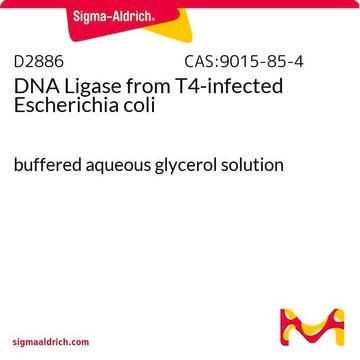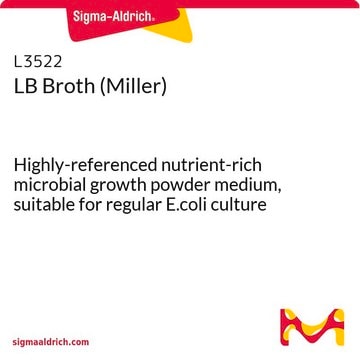DNALIG-RO
Roche
T4 DNA Ligase
solution, from Escherichia coli(NM 989), suitable for activity assay
Synonim(y):
dna ligase, t4
About This Item
Polecane produkty
pochodzenie biologiczne
Escherichia coli (NM 989)
Poziom jakości
rekombinowane
expressed in E. coli
opis
recombinant form of the enzyme from T4 phage
Postać
solution
aktywność właściwa
~3000 units/mg protein
opakowanie
pkg of 100 U (10481220001 [1 U/μl])
pkg of 500 U (10716359001 [1 U/μl])
pkg of 500 U (10799009001 [5 U/μl])
producent / nazwa handlowa
Roche
Parametry
4-22 °C optimum reaction temp.
metody
activity assay: suitable
optymalne pH
7.2-7.8
temp. przechowywania
−20°C
Powiązane kategorie
Opis ogólny
Contents
T4 DNA Ligase, supplied with 10x concentrated ligation buffer that includes ATP.
Specyficzność
Zastosowanie
Jakość
Tested for the absence of deoxyribonucleases and exonucleases, according to the current Quality Control procedures.
Definicja jednostki
Volume Activity: 1 x 103 U/ml; 5 x 103 U/ml
Uwaga dotycząca przygotowania
Working solution: For dilution of the enzyme Roche recommends using a buffer containing the components of the storage buffer: 20 mM Tris-HCl, 60 mM KCl, 1 mM EDTA, 5 mM dithoerythritol, 50% glycerol (v/v), pH 7.5 (4 °C).
Inne uwagi
Kod klasy składowania
12 - Non Combustible Liquids
Klasa zagrożenia wodnego (WGK)
WGK 1
Temperatura zapłonu (°F)
does not flash
Temperatura zapłonu (°C)
does not flash
Certyfikaty analizy (CoA)
Poszukaj Certyfikaty analizy (CoA), wpisując numer partii/serii produktów. Numery serii i partii można znaleźć na etykiecie produktu po słowach „seria” lub „partia”.
Masz już ten produkt?
Dokumenty związane z niedawno zakupionymi produktami zostały zamieszczone w Bibliotece dokumentów.
Nasz zespół naukowców ma doświadczenie we wszystkich obszarach badań, w tym w naukach przyrodniczych, materiałoznawstwie, syntezie chemicznej, chromatografii, analityce i wielu innych dziedzinach.
Skontaktuj się z zespołem ds. pomocy technicznej








